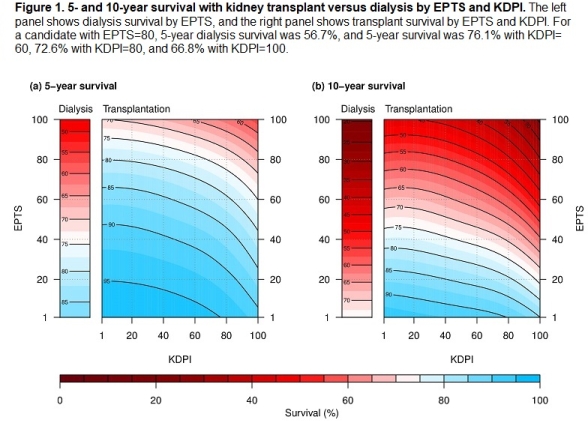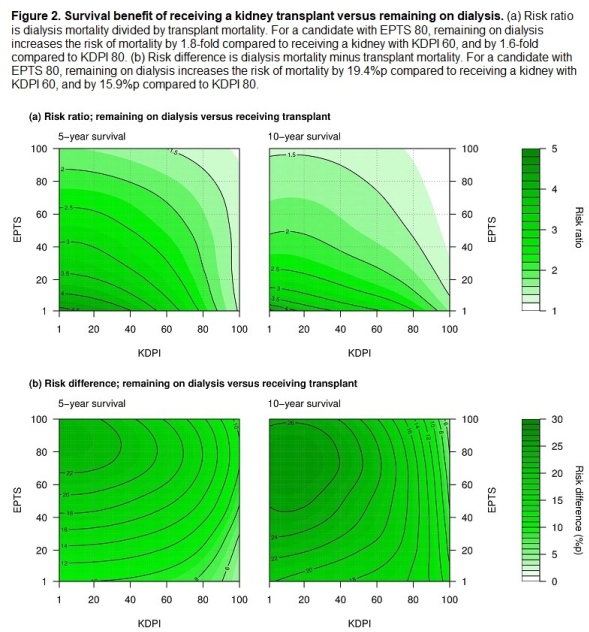Predicting Survival after Deceased-Donor Kidney Transplants by Donor-Recipient Match: Who Can Tolerate a High-KDPI Kidney?
Johns Hopkins School of Medicine, Baltimore, MD.
Meeting: 2018 American Transplant Congress
Abstract number: 27
Keywords: Allocation, Donors, Kidney transplantation, marginal, Prediction models
Session Information
Session Name: Concurrent Session: Kidney Deceased Donor Allocation - 1
Session Type: Concurrent Session
Date: Sunday, June 3, 2018
Session Time: 2:30pm-4:00pm
 Presentation Time: 2:42pm-2:54pm
Presentation Time: 2:42pm-2:54pm
Location: Room 6E
Deceased-donor kidney transplantation (DDKT) with high-KDPI kidneys carries an additional risk of mortality and graft failure, which could be tolerable for some candidates but detrimental for others. We quantified how the impact of high-KDPI differs by the recipient's EPTS by examining all combinations of KDPI and EPTS using a machine learning algorithm.
METHODS: Using SRTR data from 2005-2016, we estimated 5-/10-year post-KT survival of adult deceased-donor kidney-only transplant recipients for all combinations of KDPI and EPTS using random forests. With this method, the interaction of KDPI and EPTS on survival can be characterized in a flexible manner. To evaluate survival benefit of KT over dialysis, we also estimated 5-/10-year survival of all adult DDKT candidates on the waitlist using a Weibull model with EPTS and its cubic splines as predictors.
RESULTS: We studied 120,818 KT recipients and 337,797 waitlisted candidates. For a candidate with EPTS=20, 5-year dialysis survival was 81.4%. With KT, 5-year survival increased to 93.1% with a kidney of KDPI=60, 91.1% with KDPI=80, and 86.5% with KDPI=100. For a candidate with EPTS=80, 5-year dialysis survival was 56.7%, and 5-year post-KT survival was 76.1% with KDPI=60, 72.6% with KDPI=80, and 66.8% with KDPI=100 (Figure 1). Mortality risk was higher with dialysis compared to KT in all EPTS-KDPI matches, with 5-year risk ratios ranging from 1.20 (EPTS=100/KDPI=100) to 4.64 (EPTS=1/KDPI=1). For a candidate with EPTS=80, remaining on dialysis increased 5-year mortality by 1.8-fold compared to receiving a kidney with KDPI=60, 1.6-fold with KDPI=80, and 1.3-fold with KDPI=100 (Figure 2).
CONCLUSION: Our model may assist clinicians in making more personalized decisions for their KT candidates when considering kidney offers.
CITATION INFORMATION: Bae S., Garonzik Wang J., Jackson K., Thomas A., Luo X., Massie A., Segev D. Predicting Survival after Deceased-Donor Kidney Transplants by Donor-Recipient Match: Who Can Tolerate a High-KDPI Kidney? Am J Transplant. 2017;17 (suppl 3).
To cite this abstract in AMA style:
Bae S, Wang JGaronzik, Jackson K, Thomas A, Luo X, Massie A, Segev D. Predicting Survival after Deceased-Donor Kidney Transplants by Donor-Recipient Match: Who Can Tolerate a High-KDPI Kidney? [abstract]. https://atcmeetingabstracts.com/abstract/predicting-survival-after-deceased-donor-kidney-transplants-by-donor-recipient-match-who-can-tolerate-a-high-kdpi-kidney/. Accessed December 28, 2025.« Back to 2018 American Transplant Congress


